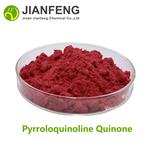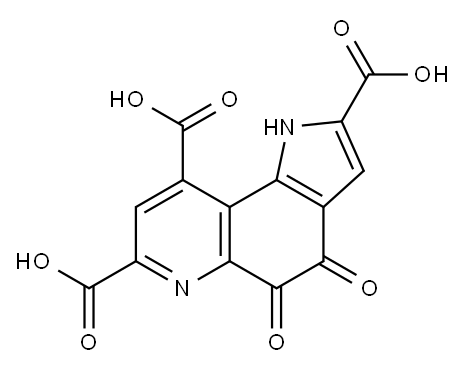Pyrroloquinoline Quinone: A Comprehensive Overview
May 14,2024
Introduction
Pyrroloquinoline quinone (PQQ), a small quinoprotein found in plant and animal tissues, has emerged as a subject of interest due to its role in various biochemical pathways. Also known as methoxatin, Pyrroloquinoline quinone is distinguished by its redox-cycling ability, which enables it to serve effectively as an antioxidant. This unique capability allows Pyrroloquinoline quinone to participate actively in the regulation of cellular functions and defense against oxidative stress. It has been increasingly studied for its potential benefits in enhancing mitochondrial efficiency and its protective effects on neural health and development[1].

Figure 1 Characteristics of Pyrroloquinoline quinone
Synthesis of Pyrroloquinoline Quinone
The synthesis of Pyrroloquinoline quinone occurs through a fascinating bioconversion process in microbial systems. Originally isolated from methylotrophic bacteria, Pyrroloquinoline quinone is synthesized via a complex pathway that involves the condensation of tyrosine, glutamate, and acetate. This pathway is integral to its role in bacterial redox reactions and growth processes. In chemical laboratories, Pyrroloquinoline quinone can be synthesized by the cyclization and oxidation of these precursors under controlled conditions. Advances in synthetic chemistry have also enabled the replication of this molecule through simpler organic compounds, allowing for more extensive study and availability. Researchers have further refined these methods to improve yield and purity, making Pyrroloquinoline quinone more accessible for both academic and commercial applications.
Key Components of Pyrroloquinoline Quinone
Pyrroloquinoline quinone consists of a tricyclic quinone and a quinolone segment, which confer the molecule's unique electrochemical properties. The core structure allows PQQ to accept electrons and act as a redox agent, a feature that is central to its biological activity. Its molecular configuration makes it highly effective in capturing and neutralizing free radicals, thereby protecting cellular components from oxidative damage. Furthermore, this configuration enables PQQ to facilitate a variety of biological functions, including cell signaling and growth regulation. Its ability to modulate protein kinases and protect neurons highlights its potential as a therapeutic agent in neurodegenerative and cardiovascular diseases.
Applications of Pyrroloquinoline Quinone
Pyrroloquinoline quinone's role extends beyond a simple antioxidant. It is crucial in cell signaling, growth, and survival pathways. Its involvement in redox modulation makes it vital for supporting mitochondrial function, which has implications for energy production and metabolic health. Moreover, Pyrroloquinoline quinone is used in dietary supplements aimed at enhancing cognitive health, improving memory and attention, and supporting overall neurological function. Its neuroprotective properties are also being explored in the context of neurodegenerative diseases like Alzheimer's and Parkinson's disease.
In agriculture, Pyrroloquinoline quinone's growth-promoting properties have been utilized to enhance crop yield and stress resistance. Furthermore, its potential in biotechnology for enzymatic reactions is being tapped into, given its ability to stabilize enzymes and enhance their activity under various conditions.
Storage of Pyrroloquinoline Quinone
Proper storage of Pyrroloquinoline quinone is essential to maintain its efficacy and stability. Pyrroloquinoline quinone should be stored in a cool, dry place, away from light and moisture. It is typically stable under normal storage conditions, but care must be taken to prevent exposure to strong oxidizing agents and high temperatures, which can lead to degradation. In industrial settings, Pyrroloquinoline quinone is often stored as a lyophilized powder, which ensures its long-term stability and facilitates ease of transport and use.
Conclusion
Pyrroloquinoline quinone is a fascinating molecule with a broad spectrum of applications in health, agriculture, and technology. Its unique chemical structure and properties not only make it an essential antioxidant but also a valuable component in promoting growth and enhancing biological functions. With ongoing research, the potential uses of PQQ are expanding, making it a significant focus in the fields of biochemistry and molecular biology. As our understanding of PQQ deepens, so too will its integration into new and innovative solutions for health and industry challenges[2].
References
[1]Akagawa M, Nakano M, Ikemoto K. Recent progress in studies on the health benefits of pyrroloquinoline quinone[J]. Bioscience, biotechnology, and biochemistry, 2016, 80(1): 13-22.
[2]Rucker R, Stites T, Steinberg F, et al. Physiological importance of pyrroloquinoline quinone[J]. Biochemistry and Molecular Biology of Vitamin B 6 and PQQ-dependent Proteins, 2000: 61-66.
- Related articles
- Related Qustion
- Pyrroloquinoline Quinone: Synthesis and Biology in Antimicrobial Effects and Neuroprotection Jan 10, 2024
Pyrroloquinoline quinone's synthetic aim to create the tricyclic pyrroloquinolinedione scaffold. It exhibits antimicrobial effects and neuroprotective properties, suggesting therapeutic potential.
- Pyrroloquinoline quinone: properties, mechanism of action and applications Aug 16, 2023
PQQ is a versatile compound that have antioxidant, immune booster, potential health benefits and consult healthcare professional for supplementation.
- WHAT YOU CAN GAIN FROM TAKING PYRROLOQUINOLINE QUINONE (PQQ) Dec 6, 2019
A great example of a nootropic that has a lot of benefits, but isn’t examined closely is pyrroloquinoline quinone. While many may focus on the surface level benefits from taking it, understanding how it works reveals the full impact it can
Triphenyl phosphite (TPhP) is a versatile chemical compound that serves as a critical element in various industrial and chemical processes.....
May 14,2024APICinnamic acid (C9H8O2) is characterized by a crystalline structure and typically appears as white to light yellow crystals.....
May 14,2024APIPyrroloquinoline quinone
72909-34-3You may like
Pyrroloquinoline quinone manufacturers
- Pyrroloquinoline Quinone
-

- $0.00 / 1KG
- 2024-06-01
- CAS:72909-34-3
- Min. Order: 1KG
- Purity: 99%
- Supply Ability: 2000KG/MONTH
- Pyrroloquinoline Quinone
-

- $0.00 / 1kg
- 2024-06-01
- CAS:72909-34-3
- Min. Order: 0.01kg
- Purity: 99%
- Supply Ability: 100kg
- Pyrroloquinoline Quinone
-

- $5.00 / 10g/Bag
- 2024-05-31
- CAS:72909-34-3
- Min. Order: 10g/Bag
- Purity: 99% up
- Supply Ability: 20 tons




